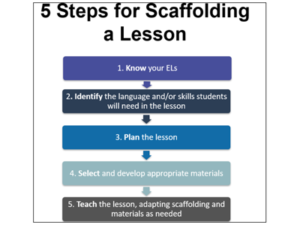Can you run before you can walk? Can you jump before you can stand? Can you sing before you speak?
In education, there are a sequence of learning stages that apply to students, and it begins with understanding the progression of curriculum, how to progress skills in a scaffolding format and providing formative assessment for learnings to progress. “It is important to understand what learning progressions are, how they help us, and how they are developed.” (Helyn, K and Care, E. 2018)
First, teachers must identify what must be learned and have a foundation of knowledge of how skills progress over time. It is not enough to only know the curriculum of the grade level, but also possess the knowledge of previous and future levels. This holistic knowledge builds scaffolding from curriculum for future grade levels and allows a smooth continuum. Knowing or foreseeing how student learning scaffolds “helps design classroom tasks that are within the zone of proximal development for their students.” (Helyn, K and Care, E. 2018) As educators, identifying what must be learned for students allows for a preparation of a systematic approach rather than sporadic one, and in turn- sets students up to master each building block in the learning progression to follow. An example would be writing an essay. You wouldn’t ask a student in Kindergarten to write an essay, as they are learning their alphabet and how to write their name. Gr. 1 students are learning to spell basic words. Gr. 2’s are expanding vocabulary knowledge with their spelling. Gr. 3’s are writing simple sentences “I like cats. My cat is big.” Gr. 4’s are writing paragraphs strictly about one subject and the paragraph is simple sentences combined. Gr. 5’s might be asked to write paragraphs with a topic sentence. Gr. 6’s will be asked to write complex/ compound sentences with topic sentences and finally in Gr. 7, you can teach introduction paragraphs, body paragraphs and concluding paragraphs and put it all together. See how that progressed? “Learning involves patience and time.” (First Peoples Principal of Learning #7)
As more complex skills are built on foundational skills, we have to provide feedback for learners in order for them to progress. “It is critical for teachers to be able to identify the behaviors that relate to these skills if they are to intervene at the appropriate levels of challenge.” (Helyn, K and Care, E. 2018) Formative assessment that is gathered during ongoing instruction helps teachers adjust their teaching style and students adjust their learning style. The formative assessment process tends to be successful if teachers set a routine to collect “evidence of a student’s progress toward mastery of each key building block in a learning progression. If a student is having trouble with building blocks, assessments can pinpoint why.” (Popham. J. W. 2007)
In Serhat Kurt’s Vygotsky’s Zone of Proximal Development and Scaffolding, he talks about Vygotsky’s theories in regards to learning progressions. Not only does he agree that purposeful sequencing of teaching and learning expectations across multiple developmental stages, ages, or grade levels is effective, but also that it cannot be achieved alone. This is where the Zone of Proximal Development comes in. We start with what the student can do, identify what they can do with help and what they cannot do (yet). The thought behind learning progressions is that the same level of learning could not be reached if an individual worked alone or without guidance as opposed to with peers or with a higher knowledge (teacher/ professor) to guide. (Kurt, S. 2020) The goal is to be able to bring students into the zone of proximal development, and guide them towards the middle of the circle to the “I Can” phase.
Educators must understand the series of progression students will face academically, social emotionally and physically, before implementing curriculum. They must assess where students came from, where they are at and where they are going prior to approaching material. Once students have been assessed appropriately to continue their learning progression, it is imperative that teachers continue formative assessment for the growth of the learner. With teacher approach, guidance and assessment through this scaffolding process, there is no doubt of the affective outcome for student learning progression. The goal? When we have finally reached the top of the scaffold, students will be able to direct their own learning.
Resources:
Helyn, K and Care, E. March 27, 2018. Learning progressions: Pathways for 21st century teaching and learning.
Kurt, S. “Vygotsky’s Zone of Proximal Development and Scaffolding,” in Educational Technology, July 11, 2020.Retrieved from https://educationaltechnology.net/vygotskys-zone-of-proximal-development-and-scaffolding/
McLeod, S. 2019. The Zone of Proximal Development and Scaffolding
Popham. J. W. April 2007. All About Accountability / The Lowdown on Learning Progressions. Volume 64, Number 7. The Prepared Graduate Pages 83-84.
Staehr Fenner, D. February 13, 2019. 5 Practical Steps to Scaffold Lessons for English Learners. Retrieved from: https://home.edweb.net/webinar/ell20190213/
